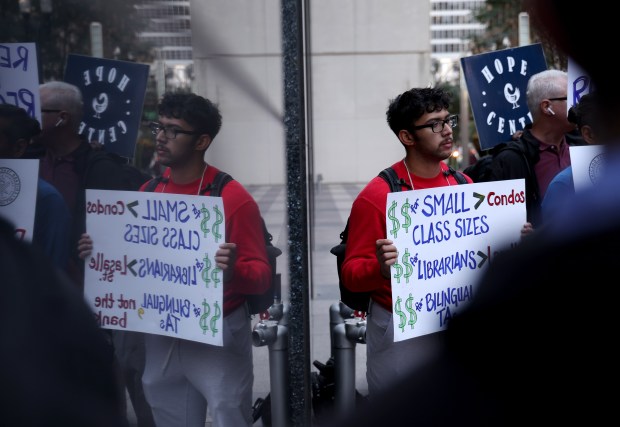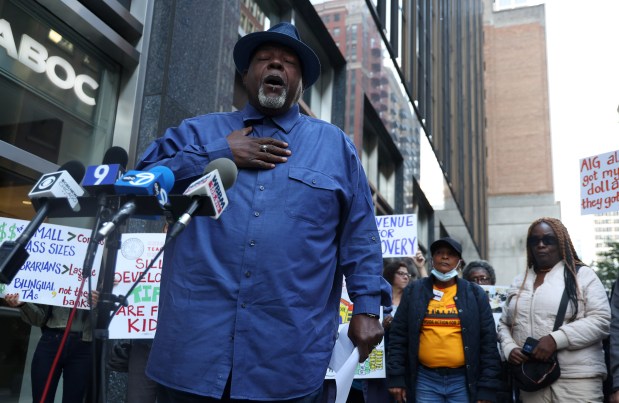The sharply-divided leaders of Chicago Public Schools and the Chicago Teachers Unions seem primed to unite around one broad solution to solve the school district’s budget woes: tax increment financing revenue.
Both CPS CEO Pedro Martinez and CTU leadership urged city officials this week to use TIF revenue — property tax dollars collected to spur economic development projects — to help cover the district’s major budget stressors, including the cost of non-teacher pension payments and a still-under-negotiation contract with teachers.
CPS and CTU’s proposals vary, however. Martinez is lobbying the City Council to give the school district a massive infusion of surplus money from the TIF districts, while teachers union leaders added a call for a sped-up, near-total end to TIF districts that would face daunting political hurdles to give the district an estimated annual payout of $1 billion.
“Our school communities cannot afford the cost of returning to the cuts and consolidation and closures of the past. The funds are there,” CTU research director Pavlyn Jankov said at a news conference Wednesday.
After Wednesday’s City Council meeting, Mayor Brandon Johnson said he “has always been very clear” that he would provide the school district with a TIF surplus. “Whatever is there that we can surplus, I’ve made a commitment,” he said. “Those are my values, that’s not something anybody had to call me to do.”
The teacher’s union is also facing a new lawsuit filed Wednesday demanding it release an audit disgruntled members say is required and overdue.
The city’s 124 TIF districts are an attractive target for the cash-strapped school district and the union. The districts collectively raked in $1.2 billion by the end of 2023, according to data maintained by the city’s Department of Planning and Development. Their total fund balance at the end of the year was over $3 billion.
But they are also closely guarded by aldermen, who rely on their TIF districts’ piggy banks to deliver on economic development projects in their wards or fix-ups to local parks, schools and roads.
While Johnson has also signaled an appetite to reduce the city’s reliance on the districts — spearheading a new bond program made possible by letting several TIFs expire — he has also supported the expansion of the Pilsen TIF and using the city’s biggest money-making TIF district to fund the transition of older office buildings along LaSalle Street into housing developments.
The teachers union called on aldermen to “de-TIF” the city at a LaSalle Street news conference ahead of Wednesday’s council meeting. A group of CTU organizers held signs calling for the reprioritization of taxpayer dollars and taking aim at the high-powered businesses in buildings around them — including many of the same buildings winning TIF money from Johnson for office-to-housing conversions.
“Silly developers, TIFs are for kids” and “Revenue for recovery,” signs read.
The CTU’s Jankov stressed the need to act urgently to phase out TIFs as the district faces “a critical need for resources.” He said such a TIF takedown could happen this year and provide over $1 billion to CPS.
Martinez, meanwhile, requested that aldermen authorize sending additional TIF surplus to help CPS cover the disputed $175 million pension payment and $150 million for the new contract with the Chicago Teachers Union. In briefings with the City Council’s Women’s Caucus this week, he said a TIF surplus could help the district stave off costly borrowing while school officials continue advocating for long-term funding solutions in Springfield.
Martinez warned “without additional funding, CPS will be forced to cover these costs with cuts or additional borrowing that will jeopardize the district’s future financial stability,” according to slides from Martinez’s presentation to the Women’s Caucus obtained by the Tribune.
Martinez told the Tribune Wednesday afternoon he asked Johnson in April for a TIF sweep sufficient to provide CPS with at least $452 million this year. The sum would require Johnson to declare a record surplus of nearly $1 billion.
The mayor initially agreed to a sweep netting CPS about $160 million, Martinez said. He and the Board of Education were counting on the money when it approved a budget without funding non-educator pension payments, Martinez said.
“We knew that these funding sources already existed,” he said. “We feel there is a reasonable request.”
Chicago “freezes” property values within TIF districts, making increasing values inaccessible to other taxing bodies like CPS, the Chicago Park District, or Cook County.
Martinez estimates $19 billion of property value is stuck in TIFs that CPS can’t tax against. Without those TIFs in place, CPS would be able to collect $600 million more in annual revenue, according to his presentation. The district’s “inability to access TIF dollars limits our ability to solve the District’s deficit challenges and find a sustainable solution” to pay for non-teacher pensions, it said.
But CPS’s access to TIF dollars is more complicated. Over the years, the city has historically tried to shift the money back to CPS by either disbursing surplus TIF dollars or by using the taxing district money to pay for school-specific capital improvements within TIF districts.
When the city surpluses TIF, CPS is the biggest beneficiary. Johnson’s 2024 budget included a record TIF surplus of $433.8 million. Of that, the city’s cut was $100 million, while CPS’s was $226 million.
Johnson has not yet detailed the TIF surplus planned for 2025, and the city typically uses TIF surplus revenue to plug its own budget gaps. Johnson is staring down a nearly $1 billion deficit in next year’s budget.
TIF dollars typically must be spent on specific capital projects within their geographic boundaries. But when the city declares its TIF surplus each year — freeing up money not already dedicated to a TIF project or other eligible cost — that money can be used as a general revenue source.
Aside from TIF surplus, the city has dedicated TIF revenues directly to CPS projects.
Between 1984 and 2019, Chicago spent $1.36 billion in TIF on school-related projects, according to the city’s 2019 annual financial analysis. A hefty portion came through the controversial Modern Schools Across Chicago program. Spearheaded by Mayor Richard M. Daley, MASC issued bonds paid back with TIF revenues to pay for the construction or renovation of roughly two dozen school buildings over 7 years.
From 2019 onward, city officials approved roughly $309 million in TIF spending on school projects, ranging from building new gyms or replacing grass fields with turf to replacing or repairing mechanical systems, plumbing, roofs and windows, according to data maintained by the city’s TIF Investment Committee.

CTU’s Jankov acknowledged some TIFs are already obligated to pay for ongoing projects, but argued the rest of that money could be moved into schools. Jankov said the mayor has already been open to expiring TIFs, “as they should be.” The union is calling for “fast-tracking” of that phase-out, he said.
Jankov argued that while some TIF money has been invested in working-class communities, the overwhelming use of TIF has been “to create these large-scale developments downtown, adjacent to downtown.”
“Overall, when we’re facing the budget crisis, we have to prioritize public services and think about those more structural, long-term ways to achieve those kinds of systems,” Jankov said.
It’s unclear whether the plan — which was not detailed in writing — could even work.
State statute does lay out when TIFs must be repealed: if there has been no activity or expenditures in advancement of the district’s redevelopment plan within its first seven years. City policy also allows for districts to be terminated early based on inactivity, if designated projects are completed and paid for, or if district’s overall redevelopment goals are met.
David Merriman, a professor of Urban Planning at the University of Illinois at Chicago and a national TIF expert, said the proposal would very likely “have some very negative consequences,” including potential bond defaults or leaving ongoing projects unfinished. Some TIF projects could be “scrapped or ended early,” he said, but should be examined “on a TIF by TIF and project by project basis.”
The proposal to end all city TIFs and sweep their funds “does not seem like a serious public policy proposal,” he said.
When asked at Wednesday’s CTU news conference about the feasibility of a TIF phase-out, 5th District school board candidate Jitu Brown said the city could make it happen “as soon as the political will is there to do it.”

Commissioner Tara Stamps, CTU’s administrator of new teacher development who replaced Mayor Johnson on the Cook County board, spoke about how the TIF sweep would help ensure equitable access to school programming across Chicago.
“We have a solution, because that’s what teachers do,” she said. “Put the money back in our children. Take it away from rich billionaires who can do it on their own.”
Group files lawsuit against CTU calling for audit
Meanwhile, on Wednesday, the Liberty Justice Center filed a lawsuit on behalf of four CTU members, which alleges the union has not complied with its contractual duties to produce its annual audit detailing union finances. The last published CTU audit covered the first half of 2019, according to the plaintiffs.
“Under CTU’s Constitution and Bylaws, Article VI, Section 1(d), the union is required to ‘furnish an audited report of the Union which shall be printed in the Union’s publication,’” wrote Dean McGee, senior counsel for educational freedom in an October email to CTU President Stacy Davis Gates and CTU Fiscal Secretary Maria Moreno, the lawsuit states.
Members were told that they could come to the CTU office to view an audit if they wished, McGee told the Tribune.
“In other words, their leadership is telling them that these busy educators need to take time out of their day, time away from educating students during a weekday to go to the office to view an audit that they are contractually entitled to receive directly from leadership,” McGee said.
A week after receiving the letter, CTU’s lawyers requested the identity of the plaintiffs and then CTU President Stacy Davis Gates called them out at an all-member meet and greet of pension candidates, said school social worker and CTU member Philip Weiss, who is a plaintiff. According to Weiss, Gates framed their request for transparency as being part of a “right-wing” effort.
“I’m running for office to be the pension trustee. I was the investment chair,” Weiss said. “I was the investment chair, and she’s trying to undermine it … she used this lawsuit as a way to say, here is the rotten apple in our union.”
The CTU blasted the lawsuit as “frivolous” and its filer as a “Trump-aligned right-wing firm” in a statement Wednesday afternoon.
“Filing a lawsuit for a remedy that could have been resolved with an email is scab behavior and the definition of frivolous,” Davis Gates said in the statement. “This suit isn’t about the information they already had access to. It is one more inaccurate step in those pushing Trump’s agenda in Illinois.”




